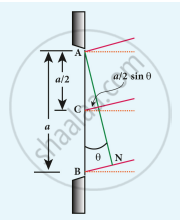Advertisements
Advertisements
Question
Discuss the special cases on first minimum in Fraunhofer diffraction.
Solution
- Divide the slit AB into two halts AC and CB.
- Two different points on the slit which are separated by the same width is corresponding points.
- The path difference of light waves from corresponding points meet at p and interfere destructive to make the first minimum.
δ = `"a"/2` sin θ
The condition for p to first minimum
`"a"/2 sin θ = lambda/2`
a sin θ = λ (first minimum)
a sin θ = 2 λ (second minimum)
a sin θ = 3 λ (third minimum)
`("a" sin theta)/(2"n") = lambda/2`(nth minimum)
APPEARS IN
RELATED QUESTIONS
Two coherent monochromatic light beams of intensities I and 4I are superposed. The maximum and minimum possible intensities in the resulting beam are ______.
First diffraction minimum due to a single slit of width 1.0 × 10-5 cm is at 30°. Then wavelength of light used is ______.
What is diffraction?
Differentiate between Fresnel and Fraunhofer diffraction.
Mention the differences between interference and diffraction.
What is a diffraction grating?
What is resolution?
What is Rayleigh’s criterion?
Discuss diffraction at single slit and obtain the condition for nth minimum.
Discuss the diffraction at a grating and obtain the condition for the mth maximum.
Discuss the experiment to determine the wavelength of monochromatic light using a diffraction grating.
What is the difference between resolution and magnification?
Light of wavelength of 5000 Å produces diffraction pattern of the single slit of width 2.5 μm. What is the maximum order of diffraction possible?
Consider sunlight incident on a slit of width 104 A. The image seen through the slit shall ______.
